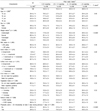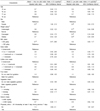1. Muckelbauer R, Libuda L, Clausen K, Toschke AM, Reinehr T, Kersting M. Promotion and provision of drinking water in schools for overweight prevention: randomized, controlled cluster trial. Pediatrics. 2009; 123:e661–e667.

2. Daniels MC, Popkin BM. Impact of water intake on energy intake and weight status: a systematic review. Nutr Rev. 2010; 68:505–521.

3. Wang YC, Ludwig DS, Sonneville K, Gortmaker SL. Impact of change in sweetened caloric beverage consumption on energy intake among children and adolescents. Arch Pediatr Adolesc Med. 2009; 163:336–343.

4. Tate DF, Turner-McGrievy G, Lyons E, Stevens J, Erickson K, Polzien K, Diamond M, Wang X, Popkin B. Replacing caloric beverages with water or diet beverages for weight loss in adults: main results of the Choose Healthy Options Consciously Everyday (CHOICE) randomized clinical trial. Am J Clin Nutr. 2012; 95:555–563.

5. Armfield JM, Spencer AJ, Roberts-Thomson KF, Plastow K. Water fluoridation and the association of sugar-sweetened beverage consumption and dental caries in Australian children. Am J Public Health. 2013; 103:494–500.

6. Ludwig DS, Peterson KE, Gortmaker SL. Relation between consumption of sugar-sweetened drinks and childhood obesity: a prospective, observational analysis. Lancet. 2001; 357:505–508.

7. Ebbeling CB, Feldman HA, Chomitz VR, Antonelli TA, Gortmaker SL, Osganian SK, Ludwig DS. A randomized trial of sugar-sweetened beverages and adolescent body weight. N Engl J Med. 2012; 367:1407–1416.

8. Malik VS, Schulze MB, Hu FB. Intake of sugar-sweetened beverages and weight gain: a systematic review. Am J Clin Nutr. 2006; 84:274–288.

9. de Ruyter JC, Olthof MR, Seidell JC, Katan MB. A trial of sugar-free or sugar-sweetened beverages and body weight in children. N Engl J Med. 2012; 367:1397–1406.

10. Malik VS, Popkin BM, Bray GA, Després JP, Willett WC, Hu FB. Sugar-sweetened beverages and risk of metabolic syndrome and type 2 diabetes: a meta-analysis. Diabetes Care. 2010; 33:2477–2483.

11. Park S, Blanck HM, Sherry B, Brener N, O'Toole T. Factors associated with low water intake among US high school students - National Youth Physical Activity and Nutrition Study, 2010. J Acad Nutr Diet. 2012; 112:1421–1427.

12. Kant AK, Graubard BI. Contributors of water intake in US children and adolescents: associations with dietary and meal characteristics-- National Health and Nutrition Examination Survey 2005-2006. Am J Clin Nutr. 2010; 92:887–896.

13. Ministry of Health and Welfare, Korea Centers for Disease Control and Prevention. Korea Health Statistics 2010: Korea National Health and Nutrition Examination Survey (KNHANES V-1). Cheongwon: Korea Centers for Disease Control and Prevention;2011.
14. Park MK. The current state of the school athletic, and policy challenges. Sport Sci. 2009; 9:2–10.
16. Ministry of Health and Welfare, Korea Centers for Disease Control and Prevention. Korea National Health and Nutrition Examination Survey [Internet]. Cheongwon: Korea Centers for Disease Control and Prevention;2012. cited 2012 Dec. Available from:
https://knhanes.cdc.go.kr/knhanes.
17. Moon JS, Lee SY, Nam CM, Choi JM, Choe BK, Seo JW, Oh K, Jang MJ, Hwang SS, Yoo MH, Kim YT, Lee CG. 2007 Korean National Growth Charts: review of developmental process and an outlook. Korean J Pediatr. 2008; 51:1–25.

19. The Korean Nutrition Society. Dieatry Reference Intakes for Koreans 2010. Seoul: The Korean Nutrition Society;2010.
20. World Health Organization (CH). Food and Agriculture Organization (US). WHO Technical Report Series 916. Diet, Nutrition and the Prevention of Chronic Diseases. Report of a Joint WHO/FAO Expert Consultation. Geneva: World Health Organization;2003.
21. World Health Organization (CH). Review and Updating of Current WHO Recommendations on Salt/Sodium and Potassium Consumption. Geneva: World Health Organization;2011.
22. Ministry of Health and Welfare, Korea Centers for Disease Control and Prevention. Analysis Guideline for Korea National Health and Nutrition Examination Survey. Cheongwon: Korea Centers for Disease Control and Prevention;2011.
23. Centers for Disease Control and Prevention (CDC). Beverage consumption among high school students --- United States, 2010. MMWR Morb Mortal Wkly Rep. 2011; 60:778–780.
24. Park S, Blanck HM, Sherry B, Brener N, O'Toole T. Factors associated with sugar-sweetened beverage intake among United States high school students. J Nutr. 2012; 142:306–312.

25. Park S, Sherry B, O'Toole T, Huang Y. Factors associated with low drinking water intake among adolescents: the Florida Youth Physical Activity and Nutrition Survey, 2007. J Am Diet Assoc. 2011; 111:1211–1217.

27. Park S, Sherry B, Foti K, Blanck HM. Self-reported academic grades and other correlates of sugar-sweetened soda intake among US adolescents. J Acad Nutr Diet. 2012; 112:125–131.

28. Isasi CR, Soroudi N, Wylie-Rosett J. Youth WAVE Screener: addressing weight-related behaviors with school-age children. Diabetes Educ. 2006; 32:415–422.
29. Rural Development Administration (KR). The Food Composition Table in Korea. 7th ed. Suwon: Rural Development Administration;2006.
30. Committee on Nutrition and the Council on Sports Medicine and Fitness. Sports drinks and energy drinks for children and adolescents: are they appropriate? Pediatrics. 2011; 127:1182–1189.






 PDF
PDF ePub
ePub Citation
Citation Print
Print




 XML Download
XML Download